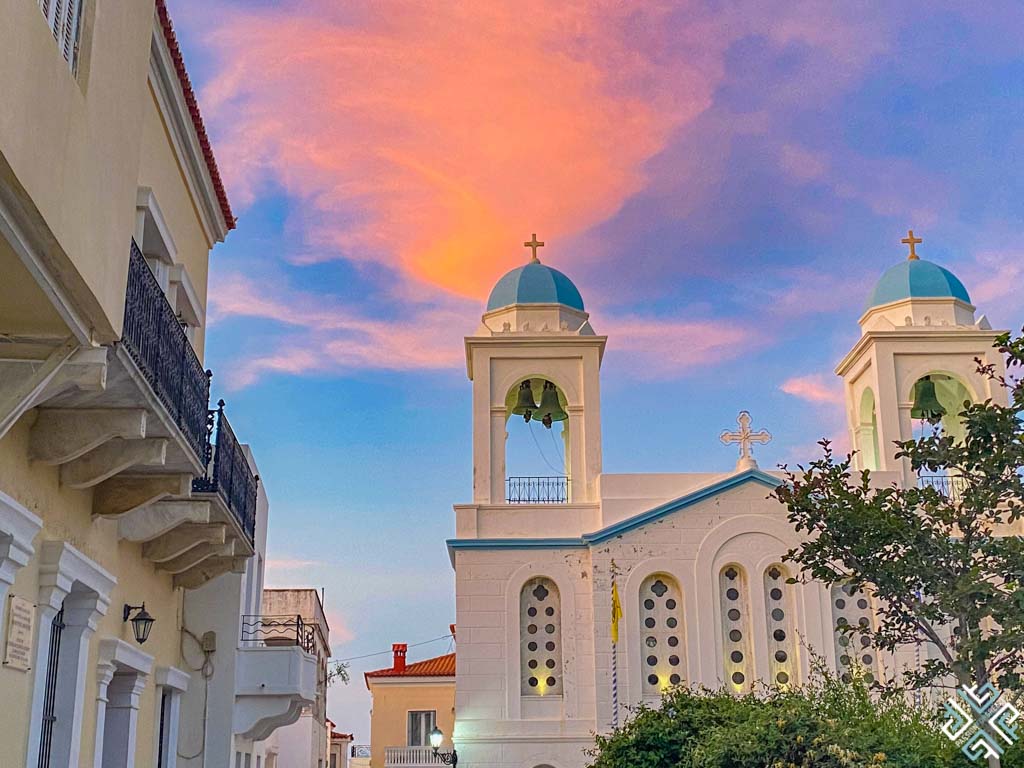Santorini has wines with as much character as the island itself. This is one of the most beautiful geological wonders of the earth. The volcano responsible for its extraordinary terrain has also given the island its unique soil. The vines of Santorini grow in an unusually porous, dry, and mineral rich earth. This gives the wines a unique character: when we speak of terroir, the wines of Santorini have quite a story to tell.
Santorini Wineries You Must Visit
Not every grape thrives in such unusual conditions, and this is also part of the magic of Santorini’s wines – the grapes themselves. Santorini has several indigenous grape varieties. In white grape varieties, there are the Aidani, Athiri, and Assyrtiko. In reds, there is the Mavrotragano and the Mandalieria. But if someone knows just one Santorini grape, it’s bound to be the Assyrtiko – the most popular. This grape produces a bright-tasting, citrusy wine, with a crisp, mineral finish.
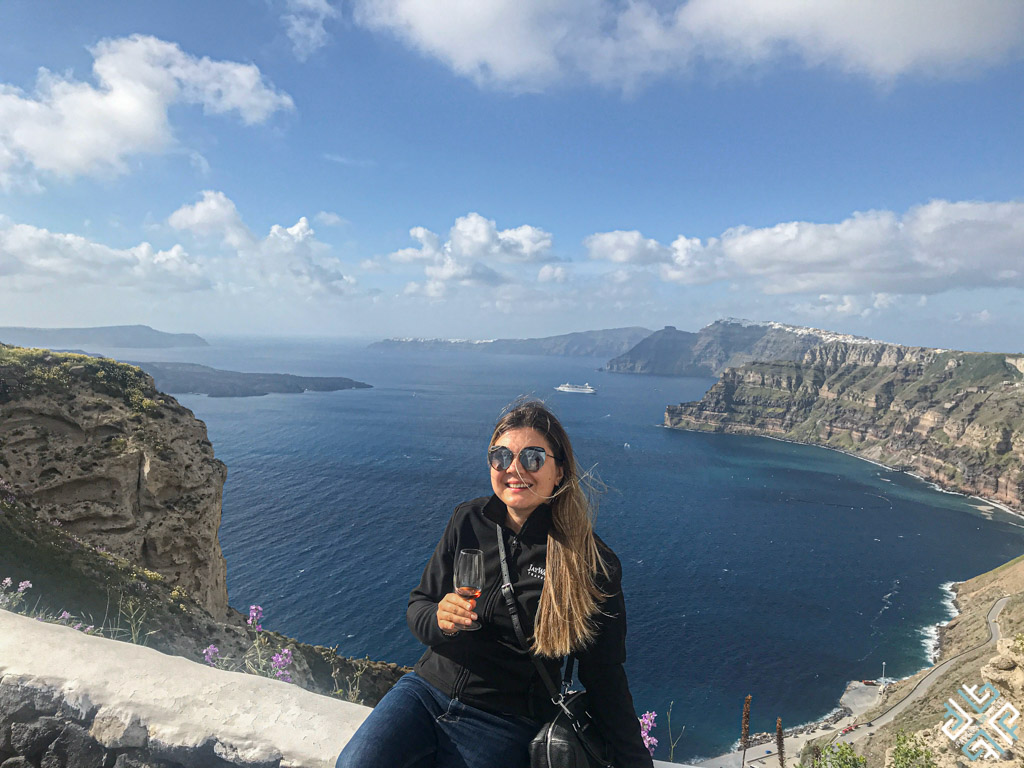
There is also another fascinating factor that makes the story of Santorini’s vines a long one. The volcanic soil is resistant to phylloxera – the aphid so destructive to vines. This means that Santroini has some extraordinarily old vines, giving wines character.
Something else unique about the wines of Sanorini is their method of cultivation. To the untrained eye, a vineyard on Santorini may not be easy to spot at first glance. Owing to both the arid and porous soil, and the strong Cycladic winds, vines are not staked above ground and in rows, but rather grown close to the ground. Wine growers train the vines in a circle – a sort of basket formation – to help enclose the grapes and protect them from the wind and the intensity of the sun.
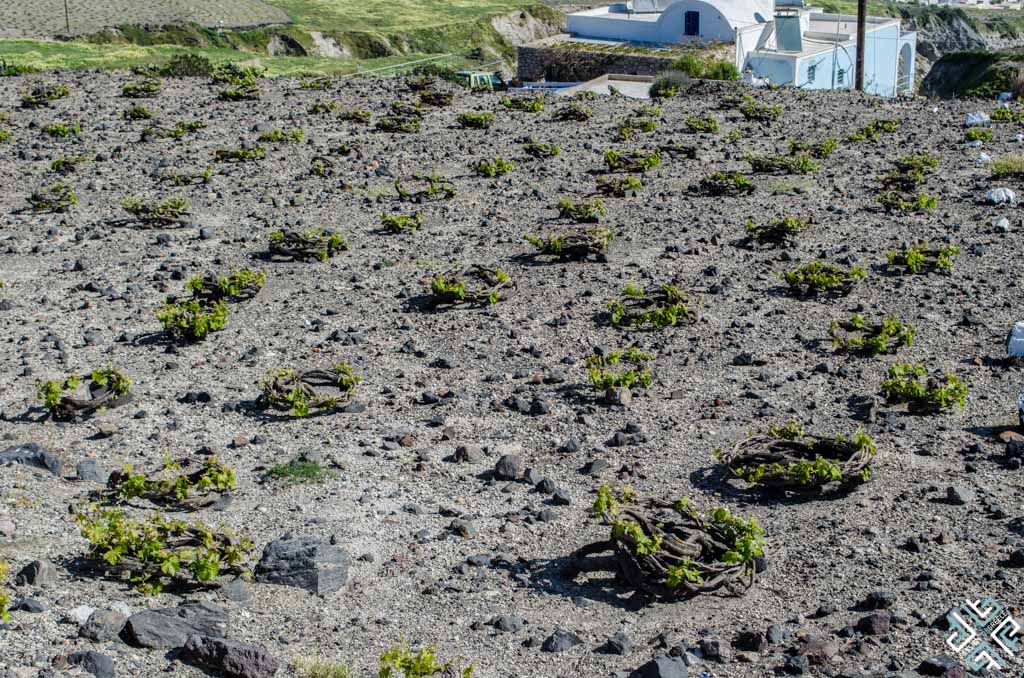
Some delicious wines you’ll be sampling are Santorini, which must contain at least 75% Assyrtiko, with the remainder Athiri or Aidani (or a combination of the two), Nychteri, which has the same designated composition as Santorini, but are often picked at night and aged for at least three months in oak barrels, and Vinsanto, made from late-harvest Assyrtiko (at least 51%) with Athiri and/or Aidani grapes which are then sun dried. The wine is then aged. The name, written as one word, distinguishes the wine from the Italian Vin Santo.
Venetsanos Winery
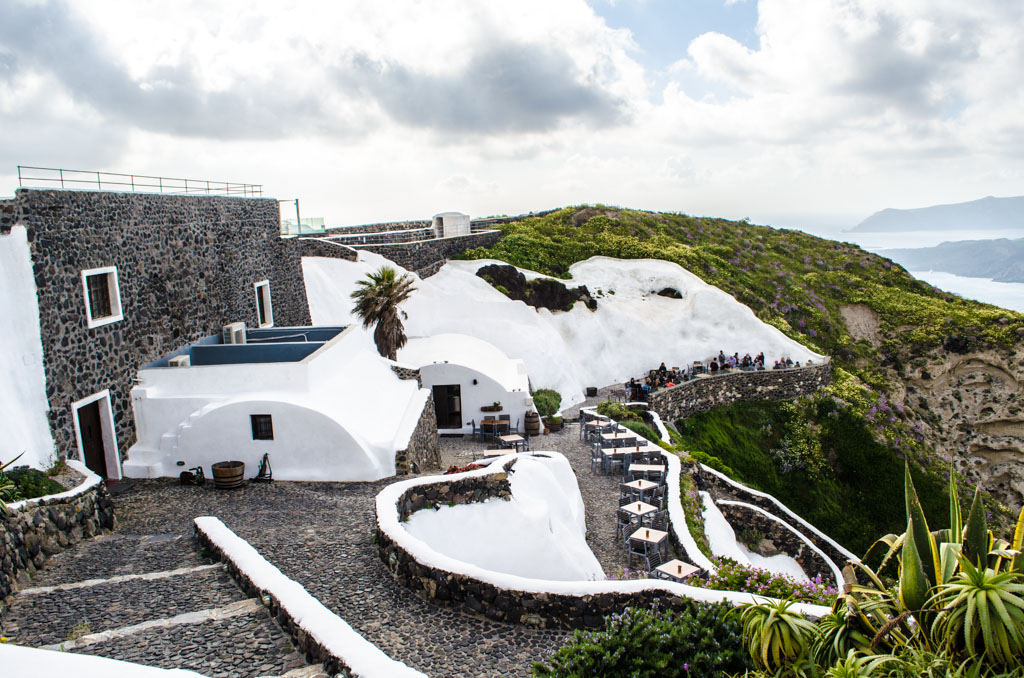
Overlooking the Caldera and above the port of Athinios, this is the first industrial winery of the island, built in 1947. It’s a beautiful and unique structure that harnesses the power of gravity for energy efficiency. The Venestantos family has a long tradition in wine making in Santorini.
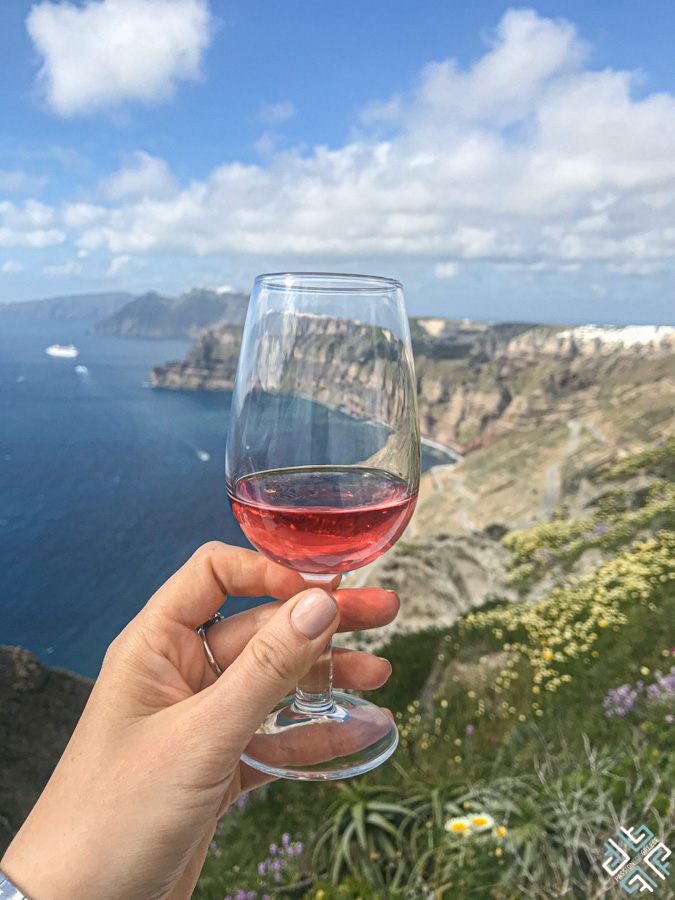
The winery produces two wines of 100% Assyrtiko grapes. The Santorini Venetsanos is from a single vineyard, and the Nyxteri Venetsanos is barrel aged for 4 months. They also produce a full and jammy red from the Mandilaria grape, as well as a rose from a blend of Mandilaria, Aidani, and Assyrtiko, and a dessert wine, naturally sweet from sundried Mandilaria grapes.
Vassaltis
Vassaltis means “Basalt” in English – the volcanic rock that was formed by the rapid cooling of the lava. It’s a beautiful and true name for a Santorini winery that aims to harness the best and most honest characteristics of the earth. This is both the newest, and the youngest of the Santorini wineries, with a young team of winemakers.
The Vassaltis winery makes a fresh and vibrant Assyrtiko, an Assyrtiko aged in oak barrels (Nichteri), and a complex and full-bodied Aidani. The modern winery in the north of the island, just 2.5 kilometers outside of Imerovigli, is beautiful and welcoming.
Gaia
On the east of the island, on a terrace by the sea, you can taste the wines of Gaia. The winery itself has repurposed a historic industrial building, originally used for sun dried tomatoes.
Thalassitis (“Thalassa” is ‘sea’ in Greek) is produced from Assyrtiko grapes that grow from mature vines – nearly 80 years old. They also have a wild ferment Assyrtiko, that uses naturally occuring wild yeast trains to determine the character of the wine. They also have a Nychteri, and their Vinsanto is produced from a mixture of both sun dried grapes and shade dried grapes, to preserve different nuances of aroma.
Gavalas
In the traditional village of Megalochori on Santorini’s eastern coast, five generations of the Gavalas family have been celebrating the uniqueness of Sanorini’s soil and grapes by making extraordinary wines. What is unique about the Gavalas winery is that, in addition to cultivating the traditional five grape varieties of Santorini, they also cultivate the much rarer indigenous grape varieties Katsano and Voudomato.
Several of their wines are multiple award winners, both nationally and internationally. These include the Santorni (Assyrtiko), the Santorini Natural Ferment, the oak-aged Nychteri, their Vinsanto, Aidani, Katsano, and Mavrotragano. They also produce a fruity and refreshing rose, from the Voudomato grape.
Estate Argyros
In a modern building in Episkopi, a true taste of Santorini wine history can be had. Estate Argyros, a 4th generation family winery, was established in 1903. It has some of the oldest vines on the island. Some of their vines are over two centuries old, for an average vine age of 70 years to create wines of character.
The estate produces several notable and awarded wines, inclusing the Santorini Argyros Assyrtiko (92 Robert Parker/Wine Advocate points), the Estate Argyros Assyrtiko (94 and 95 Robert Parker points), the oak fermented Estate Argyros (International Trophy at the Decanter awards – best dry white single varietal in the world), and a Mavrotragano (93 Robert Parker points). Their Aidani won the gold medal at the Concurs Mondiale de Bruxelles.
Art Space
This mid 19th century winery, which originally closed in 1952, has a fascinating new life as a multi-purpose space housing exhibitions, the original distillery and winery well preserved and serving now as a museum, and a modern boutique winery. They produce a Vinsanto, a Nychteri, and two dry white wines – Saint August, and Saint August Barrel Reserve.
This is a fantastic place to visit. The art space has hosted exhibitions of nearly 200 Greek and International artists, in the atmospheric carved pumice rock chambers of the old winery. You’ll find this unique cultural space just half a kilometer from Episkopi Gonias, in the middle of the island.
Domaine Sigalas
In Baxes, in the plain of Oia in the island’s north, is Domaine Sigalas, a family winery established in 1991. Many of their wines have won national and international awards over the last 18 years. Notably, their Sigalas Santorini 2011 (gold at the International Wine and Spirits Competition and at the Thessaloniki International Competition), the Sigalas Aidani 2013 (gold at the International Wine Challenge of 2014), the Sigalas Vinsanto 2004 (Gold at the Monde Selection International and at the Thessaloniki International Wine competition).
The Sigalas winery also produces a tsipouro – the traditional distilled spirit of grape marc, as well as an aged tsipouro with a golden hue, and a spirit of prickly pear that has aromas of herb and fruit.
Koutsoyannopoulos Wine Museum
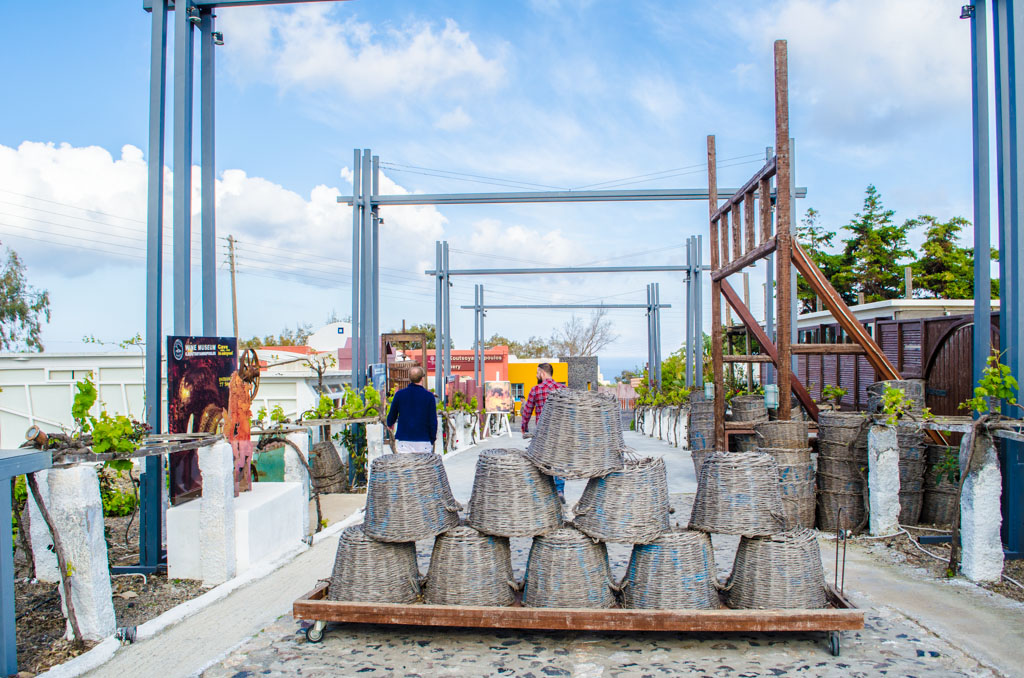
The Koutsoyannopoulos Wine Museum is in an extraordinary location – a natural labyrinth 300 meters long, located 8 meters underground. It took the Koutsoyannopoulos family tremendous dedication over two decades to create the Wine Museum in this unique space. Here, you can learn about the history of wine and the life of wine growers in Santorini for over three centuries, from 1660 – 1970.
This fourth generation family of winemakers produces a number of wines with Santorini’s indigenous grape varieties. These include two rose wines – Lava and Physalis, from a blend of Assyrtiko and Mantilaria grapes, three young white, an aged white (Nykteri), two young reds, and an aged red. They also have two two dessert wines – the Vinsanto and Kamaritis – which blends six indigenous Santorini grapes, as well as a semi-sweet aged wine. Their Vinsanto, Assyrtiko, and Nikteri have all won multiple national and international distinctions, including for the Vinsanto the Gold Medal at the Decanter World Wine Awards.


